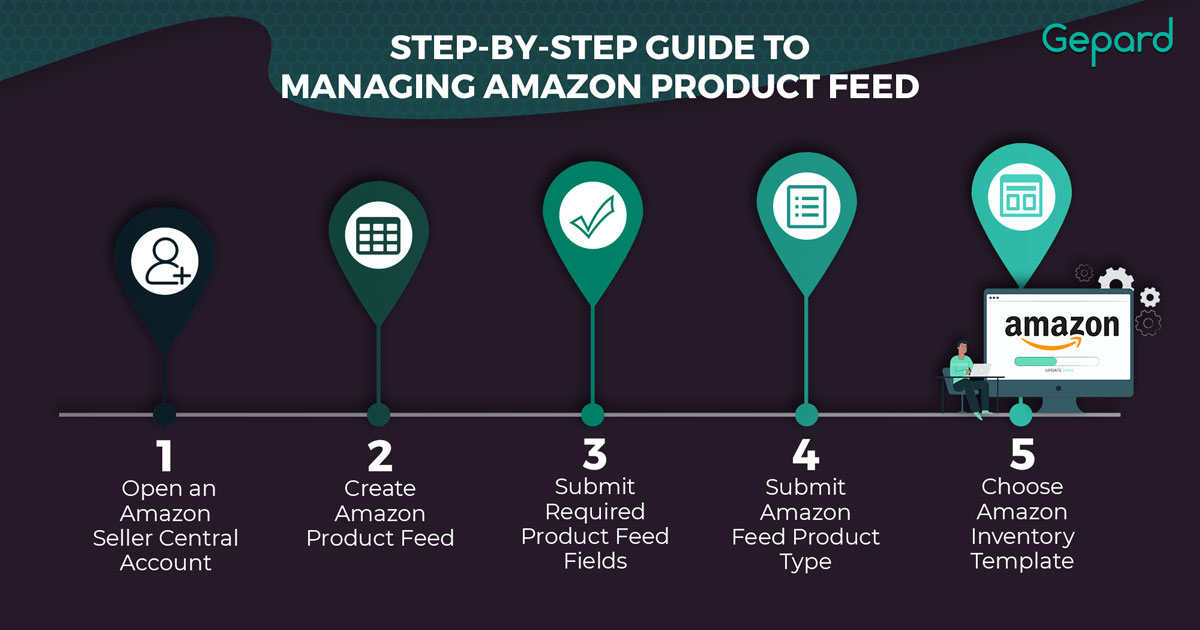How to Make Amazon Feeds Api
Mastering Amazon feed is a must-have skill for every brand conquering the world of eCommerce. Learn how to deal with the leading online marketplace and how PIM (product information management) system can help you there.
What Is Amazon Product Feed
The product feed on Amazon is a constantly refreshed record of all your products, available for sale, that includes the following attributes: title, product image, product ID, feed product type, specific product attributes as length, country of origin, brand, etc.
Just like with any other digital marketplace, Amazon data feed has its own structure andtaxonomy.
There are mandatory and recommended fields. Do not underestimate the latter ones: these fields enrich your data and make your products indexed better, which means that they'll appear higher in the listing and in all the relevant searches. It significantly increases the chance of purchase.
The more precise and rich your product data is the more chances that your potential customer can experience owning a product before even buying it.Optimizing your product data helps you draw more attention and accelerate sales. For this purpose, you can use the power of a trustworthy PIM system, such as Gepard.
Discover more about product information management in our eBook, "What is PIM now" –get your free copy now!
Getting Started With Amazon

1. Opening an Amazon Seller Central Account
To begin, sign up for an account onAmazon Seller Central. It will cost you $40 plus sales commission (usually, up to 15% per item sold). You will have to provide the following information: credit/debit card number, accepted worldwide, bank account info, tax ID number, and business details. Then you can provide your product information.
2. Creating Amazon Product Feed
Once you register your shop/brand, proceed to create your product feed.
Amazon allows you to sell almost everything. Though there are specificdemands for each category. Some products are required to be submitted only in a new condition, some could be sold only by Professional sellers. For certain products, you'll have to get approval (every time you submit a product or just during holiday sales — for instance, baby products).
Tip: useAmazon classifier to let Amazon know where to better locate your product in its catalog and help customers find you organically.
3. Submitting Amazon's Required Product Feed Fields
There are certain product data fields that are mandatory for submitting on Amazon: product title, URL and category, brand, SKU (stock keeping unit), price, UPS/EAN, MPN, image URL, shipping costs, product description, bullet points, height, length, width & weight, item package quantity, model number, and keywords.
Each category has slightly different requirements on how its products are displayed. Learn how to boost your visibility on Amazon with the latestSEO tips .
Bullet points act as a way of communication with a customer, the same as a sales assistant in a brick-and-mortar shop would do.
Here's a Quick Start Styleguideline on how to compile a proper Amazon product feed template.
4. Submitting Amazon Feed Product Type
Sometimes the value "amazon feed_product_type" is filled automatically. You may need to set it manually and select from a list of valid values.
- Download the template needed.
- Choose "Valid Values" and then "feed_product_type". Choose the one matching your product item.
- Create a "New Feed page" and choose "Open advanced commands" to insert the feed_product_type in the Amazon feed.
5. Choosing Amazon Inventory Template
The sales platform provides you with an opportunity to upload an Amazon data feed. You can download information about all your products on the marketplace. It is a file with data describing your products: availability, price, product descriptions, merchant ID, reviews, and more.
Here you can choose yourinventory file template. Notice that this option is only available to Amazon Professional Plan owners.
What is Amazon Inventory Management?
Inventory management involves creating, editing, and optimizing product feeds to create a better customer experience and accelerate purchases. Amazon lets you create and choose listing methods, generate listings individually or in bulk, design listing variations, work with product page details and images, and generally update your product content.
Go through a blog post onHow Data Feed Management Improves Product Content to learn how quality product content can boost your sales.
How to Get Your Amazon Products Found?

Optimizing your product feed on Amazon is the way to make your products indexed better, which means that your products will be shown higher in the listing and more easily found. Here are some things to pay attention to while updating your product feed:
1. Find a balance between writing for potential buyers and the AI (artificial intelligence) program of Amazon. Your product description should be appealing to humans and at the same time well ranked by Amazon search algorithms.
2. Do not skip the recommended product data fields. Submit all the info that can describe your product in the most precise way. It will make your listing indexed better and will also increase your chances to be shown in the relevant searches.
3. Do not confuse the broad meaning of SEO with Amazon SEO. The latter one aims not to find the most relevant answer to the buyer's inquiry, but to make a purchase happen. To become high ranked on Amazon, your product should solve the problem of a buyer. For example, if a user is searching for waterproof shoes, your product details should clearly show that it guarantees water protection.
5. Use Amazon A+ content to optimize your product feed. A+ content includes comprehensive images, schemes, charts, instructions, and other rich content that make your listing stand out from the crowd.
6. Think of implementing PIM (product information management) software to optimize your product feed. Entrust your product content to specialists who know how to automate data-related processes within your business and create content that converts. Explore theGepard platform to see how it can help you in your specific case.
Amazon Feed Specifications Program
Amazon has a dynamic taxonomy (which could change monthly), therefore it is hard to keep product feed updated and in the required format. Besides, as a vendor, you need to fill in on average 150+ fields for each product.
If you're selling across borders, you should keep in mind the difference in taxonomies (product data models) in each Amazon country.
In July 2018 Amazon established an AFS (Amazon Feed Specifications Program), an Amazon's data interchange standard. The purpose of the AFS is to enable vendors to effectively manage product content and sales with Amazonautomatically. A limited number of companies were invited to set up an integration.

Gepard helped numerous vendors, including Jumbo, Groupe SEB, and Denver to implement a Gepard Syndicator within an AFS SaaS project. As a result, the companies were able to speed up product data transportation and transformation, applying all necessary product feed changes automatically on a regular basis.
Learn more in acase study of how Gepard helped the manufacturers to optimize product feed that resulted in faster time-to-market, increased customer experience, better brand visibility, and more sales.
Sell on Amazon: Sell Everywhere
It's tempting to start selling your products in the largest marketplace in the world. It's even more appealing not to get vanished among millions of other brands and conquer the world of Amazon. Here's where a reliable product information management system comes to the rescue.
WithGepard PIM, you can manage your Amazon feed faster, deliver constantly updated product content to Amazon according to the platform's requirements, minimize the chances of data errors, increase your products' visibility and maximize your sales. Choose Gepard – sell everywhere.Contact us if you want to automate your data feed management on Amazon. We will be happy to assist!

marroquinprich1992.blogspot.com
Source: https://gepard.io/ecommerce-strategy/amazon-product-feed
0 Response to "How to Make Amazon Feeds Api"
Enregistrer un commentaire